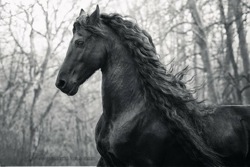Stallion
Origin
Middle English staloun, stalion, from Anglo-French estaloun, of Germanic origin; akin to Old High German stal stall
Definition
- 1: an uncastrated male horse : a male horse kept for breeding; also : a male animal (as a dog or a sheep) kept primarily as a stud
Description
A stallion is a male horse that has not been gelded (castrated). Stallions follow the conformation and phenotype of their breed, but within that standard, the presence of hormones such as testosterone may give stallions a thicker, "cresty" neck, as well as a somewhat more muscular physique as compared to female horses, known as mares, and castrated males, called geldings.
Temperament varies widely based on genetics, and training, but because of their instincts as herd animals, they may be prone to aggressive behavior, particularly toward other stallions, and thus require careful management by knowledgeable handlers. However, with proper training and management, stallions are effective equine athletes at the highest levels of many disciplines, including horse racing, horse shows, and international Olympic competition.
The term "stallion" dates from the era of Henry VII, who passed a number of laws relating to the breeding and export of horses in an attempt to improve the British stock, under which it was forbidden to allow uncastrated male horses to be turned out in fields or on the commons; they had to be "kept within bounds and tied in stalls." (The term "stallion" for an uncastrated male horse dates from this time; stallion = stalled one.) "Stallion" is also used to refer to males of other equids, including zebras and donkeys.[1]
